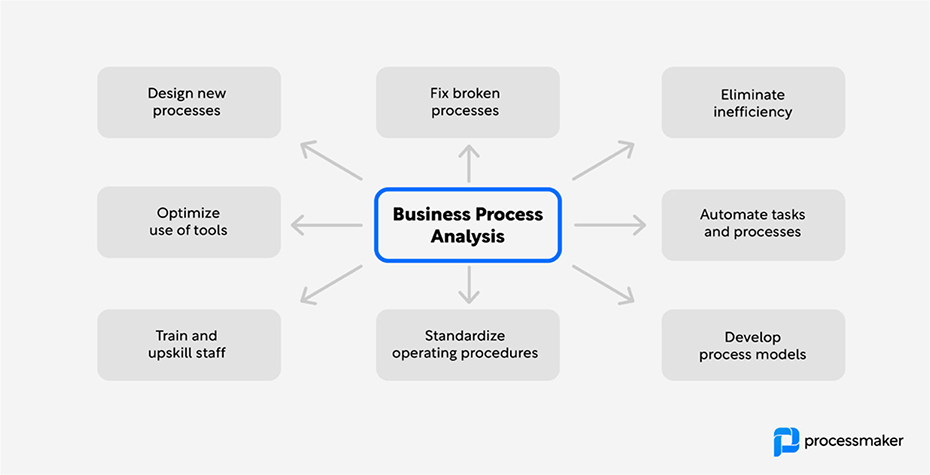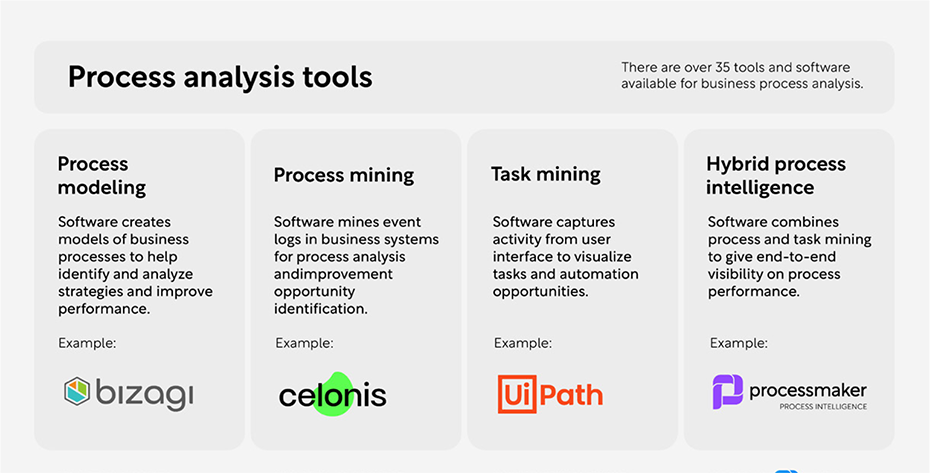Business process analysis (BPA) is one of the most effective methods for evaluating business operations in order to improve their effectiveness. Business process analysis involves thoroughly examining and understanding the processes within a business to identify inefficiencies, bottlenecks, and areas for improvement. It’s widely recognized as a cornerstone of effective business process management and an enabler for operational excellence.
In this guide, we give you all the components for creating an effective process analysis strategy for your business.
What is business process analysis?
Business process analysis is a set of methods for analyzing business processes to improve the way work is done. Systematic process analysis uncovers problems and bottlenecks and provides improvement opportunities.

Simply put, business process analysis is a way of gaining insight and visibility into the steps employees and organizations perform work to achieve their goals. By taking a deep dive into your current process, you’ll see what’s working, what needs adjustment, and the most effective path to enhanced business outcomes.
So, how do we set optimal goals for process analysis?
Essentially, process analysis aims to interpret the present state of your company’s existing procedures to spot roadblocks, inefficiencies, and duplications. Various business process analysis techniques can be used to understand the current state of a company’s existing processes. In addition, business process analysts can develop solutions to improve processes, implement changes, and monitor their impact on business performance.
When is the right time to do business process analysis?
There is no one-size-fits-all answer to this question, as the right time for conducting business process analysis (BPA) depends on various factors specific to each organization. Some common situations that may indicate it’s the right time to perform BPA include:
1. During a period of growth or expansion:
When a company is experiencing significant growth or planning to expand, it’s essential to ensure that the existing processes can accommodate the increased workload or adapt to new business models. BPA can help identify areas that need improvement or redesign to support growth effectively.
2. When facing performance issues:
If a company is struggling with declining performance, customer complaints, or employee dissatisfaction, BPA can help identify the root causes of these issues by analyzing the underlying processes. This allows the organization to address the problems proactively and improve overall performance.
3. During digital transformation initiatives:
As companies embrace digital transformation, it’s crucial to analyze and optimize their business processes to take full advantage of new technologies. BPA can help determine which processes can benefit most from digitalization and provide guidance on implementing new tools and solutions effectively.
4. During a merger or acquisition:
Mergers and acquisitions often require integrating processes from different organizations. Conducting BPA can help identify potential areas of conflict, redundancies, and inefficiencies, enabling a smoother and more successful integration.
5. As part of a continuous improvement strategy:
Many organizations adopt a continuous improvement mindset, aiming to optimize their processes and performance consistently. In this context, BPA can be conducted regularly (e.g., annually or biannually) to identify opportunities for improvement and track the success of implemented changes.
Key benefits of business process analysis
Methodological business process analysis brings a number of benefits to business operations and is a key enabler for process optimization. When effectively implemented, BPA can support the core business value chain to meet its objectives for profitable growth or strategic transformation. On a more organizational level, BPA can enable a more efficient, motivated, and competitive workforce.
Let’s look at both measurable (material) goals and less measurable (immaterial) benefits.
Material benefits of business process analysis
Business process analysis can lead to numerous measurable benefits for organizations, including increased efficiency, cost reduction, enhanced customer satisfaction, and improved employee engagement. By tracking relevant KPIs and metrics, companies can quantify the impact of BPA and demonstrate its value in driving business success and growth.
1. Increased efficiency and productivity
One of the primary objectives of business process analysis (BPA) is to identify patterns and gaps in the process flow to streamline processes and remove unnecessary steps or redundancies. By addressing these inefficiencies and bottlenecks, companies can increase their operational efficiency and productivity. This improvement can be measured through key performance indicators (KPIs) such as cycle times, throughput, or resource utilization rates.
2. Cost reduction
BPA can help organizations uncover areas of waste, such as duplicated efforts, delays, or excessive resource consumption. By addressing these issues and optimizing processes, companies can reduce their operational costs and allocate resources more effectively. Measurable benefits can be tracked through metrics like cost per unit, total cost of ownership, or return on investment (ROI).
3. Enhanced customer satisfaction
By optimizing processes and delivering higher-quality products and services, businesses can better meet customer expectations and enhance satisfaction levels. Measurable benefits in this area can be tracked using customer satisfaction scores, Net Promoter Score (NPS), or customer retention and churn rates.
Guide: Business Process Analysis in 2024
4. Improved employee happiness and engagement
Streamlined processes and well-organized work environments contribute to higher employee engagement and job satisfaction. Employees are more motivated and productive when they spend less time dealing with frustrating bottlenecks or redundant tasks. Metrics such as employee satisfaction scores (eNPS), turnover rates, or employee productivity can be used to measure the impact of BPA on employee engagement.
Immaterial benefits of business process analysis
Often the greatest value from BPA comes from the unmeasurable insights that drive operational efficiency and process excellence in indirect ways across a wide range of key performance indicators. These immaterial benefits of business process analysis can include process transparency, identification and removal of bottlenecks, and process improvement or automation insights.
1. Uncover the true state of work
Business process analysis helps organizations gain a clear understanding of their current operations by examining workflows, procedures, and interactions between various departments including undocumented shadow processes. This in-depth knowledge of how work is done allows companies to identify inefficiencies, redundancies, and areas that need improvement, ultimately leading to more effective and streamlined processes.
2. Transparent performance measurement
BPA enables businesses to establish transparent and objective performance measurements by creating a set of key performance indicators (KPIs) based on their processes. These KPIs help companies track their progress and ensure that they are meeting their business objectives. In addition, transparent performance measurement fosters accountability and encourages continuous improvement within the organization. Process analysis helps you measure how much of your work follows the happy path of agreed process models.
3. Identify and remove bottlenecks
Business process analysis helps you uncover and remove the root cause of obstacles, such as bottlenecks or swivel chair processes. Bottlenecks are points in a process where the flow of work is obstructed or slowed down, resulting in reduced efficiency and productivity. By conducting a thorough business process analysis, organizations can identify these bottlenecks and take appropriate actions to eliminate them, thereby optimizing their processes and enhancing overall performance.
4. Find process improvement opportunities
Process analysis uncovers processes and tasks that can be automated, for example, through robotic process automation. BPA allows companies to identify opportunities for process improvements by implementing changes, evaluating their effectiveness over time, and setting up continuous monitoring strategies. This can highlight areas where improvements can be made, such as reducing cycle times, minimizing errors, or increasing the quality of outputs. By capitalizing on these opportunities, businesses can stay ahead of the competition and adapt to evolving market conditions more effectively.
5. Accelerate intelligent automation
Business process analysis acts as an enabler of intelligent automation and digitalization. As companies embrace digital transformation, intelligent automation becomes increasingly important for streamlining processes and enhancing efficiency. BPA plays a crucial role in accelerating the adoption of intelligent automation by identifying processes that can benefit from automation and providing insights into how to implement these technologies effectively. This enables organizations to make better use of automation tools such as robotic process automation (RPA), artificial intelligence (AI), and machine learning (ML) to optimize their operations and drive business growth.
Business process analysis methods and tools
Business process analysis is a wide field of business process management with many methods and techniques you can use. Some common approaches include value-added analysis, gap analysis, root cause analysis, and using the Pareto technique.
Business Process Mapping
Process mapping can give a visual baseline for analyzing processes. There are many tools available to create digital flowcharts, but even a pen-and-paper process map can give process analysts a baseline shared understanding of the as-is current state of business processes. Process mapping gives analysts a tangible way to apply business process analysis in a way that can display even complex processes and process flows in an understandable way.
Value-Added Analysis
Value-added analysis is a method used to identify and evaluate the various activities within a business process that contribute to the overall value of a product or service. By analyzing each step, the method helps organizations identify which activities add value and which are wasteful or redundant. This analysis enables companies to focus on improving efficiency and reducing costs by eliminating non-value-added activities, streamlining operations, and optimizing resources.
Gap Analysis
Gap analysis is a technique used to compare an organization’s current performance with its desired performance. By identifying the gaps or differences between the two states, businesses can prioritize improvement initiatives and develop strategies to bridge the gaps. The analysis involves identifying current processes, desired outcomes, and the barriers that prevent the achievement of those outcomes. This method provides insights into areas of improvement, resource allocation, and performance management.
Root Cause Analysis
Root cause analysis is a problem-solving method that seeks to identify the underlying reasons for a specific issue or failure in a business process. By addressing the root cause rather than just treating the symptoms, organizations can implement long-term solutions that prevent the recurrence of the problem. This analysis method typically involves a systematic approach, such as the “5 Whys” technique or fishbone diagrams, to identify and understand the root cause of a problem.
Pareto Analysis
Pareto analysis is a decision-making tool based on the Pareto Principle, also known as the 80/20 rule. This principle states that 80% of the effects come from 20% of the causes. In the context of business process analysis, Pareto analysis helps organizations identify the most significant issues or causes contributing to process inefficiencies or failures. By prioritizing these key issues, organizations can focus their resources and improvement efforts on areas with the highest potential impact, leading to the most significant overall improvements.
Observation Analysis
Observation analysis is a method used to gain an in-depth understanding of how processes are executed in real-world situations. This technique involves observing employees as they perform their tasks and roles within a particular process. By watching how work is done, analysts can identify inefficiencies, bottlenecks, and opportunities for improvement that may not be apparent from merely examining process documentation.
Experience Examination Analysis
Experience examination analysis, also known as user experience analysis or stakeholder analysis, is another method employed in BPA to gather insights about a process from the perspectives of those who are directly involved in it. This technique involves conducting interviews, surveys, or focus groups with employees, customers, or other stakeholders who interact with the process being analyzed.
Different business process analysis methods can be used alongside each other by process analysts providing complementary perspectives on a process’s performance and areas for improvement. By combining these methods, organizations can develop a comprehensive understanding of their processes and identify targeted, impactful solutions to optimize their operations and enhance overall performance.
Business process analysis tools and software

In today’s market, you’ll find over 35 sophisticated software solutions ready to fulfill the process analysis needs of organizations of all shapes and sizes, from small businesses to large enterprises.
The five main categories for BPA software are:
- Process modeling tools
- BPM software
- Process mining software
- Task mining tools
- Process intelligence software
Process modeling tools
Process modeling software creates models of business processes to help identify and analyze strategies to improve performance. Process modeling tools typically include process mapping features and align with process modeling standards, such as the BPMN. The core benefit of process modeling tools is that they provide an easy-to-use way to visualize and communicate core “should be” process views that help improve the “as is” reality of business processes.
BPM software
Many business process management (BPM) tools offer BPA functionality, such as visual process mapping, process design, and collaborative process modeling functionality. They can also be used to document standard operating procedures (SOPs) and provide policy, task, and process documentation to employees. The core advantage of using a BPM suite solution for your process analysis is that it can give you a continuous reference point for process improvement across key stakeholders or business units. Comprehensive platforms like ProcessMaker offer both process mapping as well as automation capabilities in one package.
Process mining software
Process mining software utilizes data mining techniques to collect, standardize, and analyze process data from event logs found in enterprise resource systems, such as ERPs or CRMs. Process mining algorithms are used to visualize complex or large sets of data. Process mining can give a very accurate end-to-end view of processes that happen within the core enterprise systems. Process mining gives the most detailed view into business processes, often documenting thousands or millions of process variations.
Task mining tools
Task mining software utilizes task capture technology to capture task data from the user interface of employees to analyze how tasks and workflows are completed in the digital environment. While task mining looks at the details of work, it also contributes to the analysis of processes as they provide insight into core performance and automation opportunities for routine, manual tasks.
Process intelligence software
The latest process analysis tool is hybrid process intelligence software. Hybrid process intelligence embeds the best aspects of process and task mining, providing unparalleled coverage of all the processes within an organization. The real-time data collection method ensures that the improvements are continuous, and the organization is always ready for any internal and external changes.
Bottom line
In this guide, we’ve gone through the foundations of business process analysis, including the methods, benefits, and key tools used for effectively analyzing business processes. If you’re looking for an effortless and automated solution to support your BPA, look no further than ProcessMaker. Read a case study on how a business process outsourcing (BPO) company was able to identify over $2 million in process waste using ProcessMaker’s hybrid process intelligence.
Frequently Asked Questions
What is the difference between business analysis and business process analysis?
BPA focuses on examining, understanding, and improving the specific processes within an organization to optimize efficiency, reduce costs, and enhance overall performance. On the other hand, business analysis is a broader discipline that involves assessing an organization’s needs, identifying potential solutions, and providing recommendations for change. While BPA is a component of business analysis, business analysis also encompasses areas such as strategy, technology, organization structure, and change management.
What is the role of a business process analyst?
A business process analyst is responsible for analyzing, documenting, and improving an organization’s processes to enhance efficiency, productivity, and overall performance. Their duties include gathering data, conducting process analysis, identifying inefficiencies and bottlenecks, developing recommendations for improvement, and working with
stakeholders to implement changes. They may also play a role in training employees, monitoring process performance, and supporting continuous improvement initiatives.
What are the key steps in business process analysis?
The six steps of business process analysis include defining the scope, gathering information, analyzing the process, developing recommendations, implementing changes, and evaluating and adjusting. It starts with identifying the processes to be analyzed and establishing the boundaries of the analysis. Relevant data, including process documentation, performance metrics, and stakeholder input, are collected. The process is examined in detail to identify inefficiencies, bottlenecks, and opportunities for improvement. Based on the analysis, changes are proposed that address identified issues and align with organizational goals. These recommendations are then implemented and monitored, with adjustments made as needed to ensure ongoing optimization.
What are the main reasons for inefficient processes?
Inefficient processes can arise from various factors, including a lack of clear objectives, poor communication, outdated technology, redundancies, and bottlenecks. Unclear or undefined goals can lead to processes that do not align with the organization’s objectives, resulting in inefficiency. Inadequate communication between departments or employees can lead to misunderstandings, delays, and inefficiencies in process execution. Using outdated or inappropriate technology can slow down processes, reduce productivity, and hinder an organization’s ability to compete effectively. Redundant steps or duplicate efforts can waste time and resources, while bottlenecks can obstruct or slow down the flow of work, reducing efficiency and productivity.



